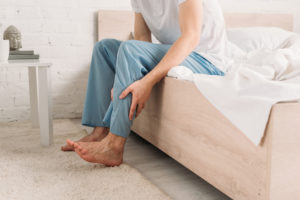10 restless legs syndrome facts

5 Key Points
-
Definition – is a neurological disorder characterised by an uncontrollable urge to move the legs, often accompanied by uncomfortable sensations.
-
Types – the condition can be primary (idiopathic) or secondary to another medical condition or medication.
-
Diagnosis – is clinical, based on the patient’s history and physical examination.
-
Treatment – includes lifestyle modifications, medications, and alternative therapies.
-
Complications – include sleep disturbances, anxiety, and depression.
1. Definition
Restless legs syndrome is a neurological disorder characterised by an uncontrollable urge to move the legs, often accompanied by uncomfortable sensations such as burning, tingling, or itching. These sensations can occur in the evening, making it difficult to fall asleep, and can also occur during periods of inactivity.
Types
There are two main types of RLS:
-
Primary (idiopathic) RLS: This is the most common type, and the cause is unknown.
-
Secondary RLS: This type is associated with another medical condition, such as iron deficiency, kidney disease, or diabetes, or is caused by a medication, such as antidepressants or antihistamines.
2. Epidemiology
- RLS affects approximately 5-10% of the general population, although it’s estimated that up to 50% of cases may be undiagnosed.
- Women are more likely to be affected than men, and the condition can occur at any age, although it’s more common in middle-aged and older adults.
3. Causes
The exact cause of RLS is unknown, although it’s thought to involve abnormalities in the brain’s dopamine and serotonin systems. Secondary RLS can be caused by a range of factors, including:
-
Iron deficiency
-
Chronic kidney disease (CKD)
-
Diabetes
-
Pregnancy
-
Certain medications (e.g. antidepressants, antihistamines)
-
Neurological disorders (e.g. Parkinson’s disease, multiple sclerosis).
4. Symptoms and Signs
The symptoms of RLS can vary in severity and frequency, but typically include:
-
An uncontrollable urge to move the legs
-
Uncomfortable sensations in the legs, such as burning, tingling, or itching
-
Symptoms worsen in the evening or at night
-
Symptoms improve with movement or activity
-
Sleep disturbances.
5. Diagnosis
Diagnosis is clinical, based on the patient’s history and physical examination. The International Restless Legs Syndrome Study Group (IRLSSG) diagnostic criteria are commonly used:
-
An urge to move the legs, usually accompanied by uncomfortable sensations
-
Symptoms worsen in the evening or at night
-
Symptoms improve with movement or activity
-
Symptoms are not accounted for by another medical condition.
Investigation
-
Blood tests to check for iron deficiency or chronic kidney disease (CKD)
-
Neurological examination to assess for underlying neurological disorders.
Differential Diagnosis
-
Peripheral neuropathy
-
Radiculopathy
-
Muscle cramps
-
Anxiety or stress-related disorders.
6. Treatment
-
Lifestyle modifications:
-
Regular exercise
-
Stretching and relaxation techniques
-
Avoiding caffeine and nicotine
-
-
Medications:
-
Dopaminergic agents (e.g. ropinirole, pramipexole)
-
Opioids (e.g. tramadol)
-
Benzodiazepines (e.g. clonazepam)
-
-
Alternative therapies:
-
Massage
-
Acupuncture
-
Cognitive behavioural therapy.
-
7. When Should I See a Doctor?
Patients with RLS should be referred to a specialist if:
-
Symptoms are severe or persistent
- There is a suspected underlying medical condition
- Treatment is ineffective or not tolerated.
8. Complications
-
Sleep disturbances
-
Anxiety and depression
-
Decreased quality of life
-
Increased risk of cardiovascular disease.
9. Prognosis
- The prognosis for RLS varies depending on the underlying cause and the effectiveness of treatment. In some cases, symptoms may resolve with treatment, while in others, symptoms may persist.
10. Prevention
-
Regular exercise and stretching
-
Avoiding caffeine and nicotine
-
Maintaining a healthy weight
-
Managing underlying medical conditions.

